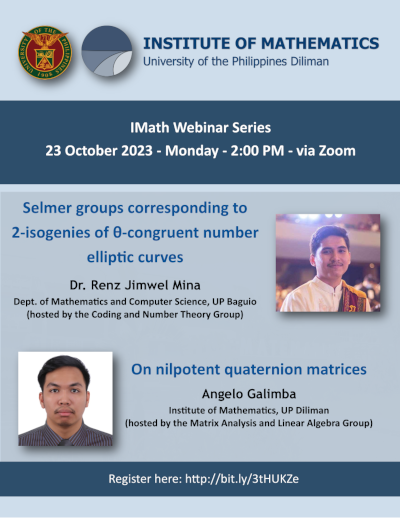IMath Webinar Series: Dr. Renz Jimwel Mina and Angelo Galimba

You’re all invited to attend our webinar on Monday, October 23, 2023 at 2:00 PM. Our speakers are Dr. Renz Jimwel Mina (from the Department of Mathematics and Computer Science, UP Baguio, hosted by the Coding and Number Theory Research Group) and Mr. Angelo Galimba (hosted by the Matrix Analysis and Linear Algebra Research Group).
Dr. Renz Jimwel Mina (Dept. of Mathematics and Computer Science, UP Baguio, hosted by the Coding and Number Theory Group)
Title: Selmer groups corresponding to 2-isogenies of theta-congruent elliptic curves
Abstract: Consider an angle \(\theta\in (0,\pi)\) such that \(\cos \theta = rs\), where \(s\) and \(r\) are relatively prime integers and \(|s| < r\). The \(\theta\)-congruent number problem asks which positive integers \(n\) satisfy the condition that \(n\sqrt{r^2-s^2}\) is the area of a triangle with angle \(\theta\) and rational sides. Positive integers satisfying this condition are called \(\theta\)-congruent. A positive integer that is not \(\theta\)-congruent is called non-\(\theta\)-congruent. This problem can be translated to the problem of determining the Mordell-Weil rank of a certain elliptic curve called the \(\theta\)-congruent number (\(\theta\)-CN) elliptic curve. In this talk, we determine the Selmer groups corresponding to certain \(2\)-isogenies on the \(\theta\)-CN elliptic curve for some family of angles \(\theta\). As a consequence, we obtain sufficient conditions so that the Selmer rank is zero. This implies that the Mordell-Weil rank of the \(\theta\)-CN elliptic curve is zero and guarantees that \(n\) is non-\(\theta\)-congruent.
Angelo Galimba (hosted by the Matrix Analysis and Linear Algebra Group)
Title: On nilpotent quaternion matrices
Abstract: Let \(\mathbb{H}\) be the quaternion division ring, and let \(M_n(\mathbb{H})\) be the set of all \(n \times n\) matrices over \(\mathbb{H}\). An \(N \in M_n(\mathbb{H})\) is nilpotent if \(N^k = 0_n\) for some positive integer \(k\). Fillmore’s theorem states that if \(A\) is an \(n \times n\) nonscalar matrix over a field \(\mathbb{F}\) and \(\lambda_1, \lambda_2, \ldots, \lambda_n \in \mathbb{F}\) such that \(\displaystyle \sum_{i=1}^n \lambda_i = \text{tr } A\), then \(A\) is similar to a matrix with diagonal \((\lambda_1, \lambda_2, \ldots, \lambda_n)\). Using an analogous result of Fillmore’s theorem for quaternion matrices, we identify an optimal or ideal number of nilpotent summands for any \(A \in M_n(\mathbb{H})\) that is a sum of nilpotent matrices. Also, we prove that every singular quaternion matrices that is not a \(2 \times 2\) nilpotent matrix is a product of two nilpotent matrices, and we show that an \(n \times n\) quaternion matrix \(A\) is a product of three nilpotent matrices of index \(2\) if and only if \(\text{rank } A \leq \dfrac{n}{2}\).
